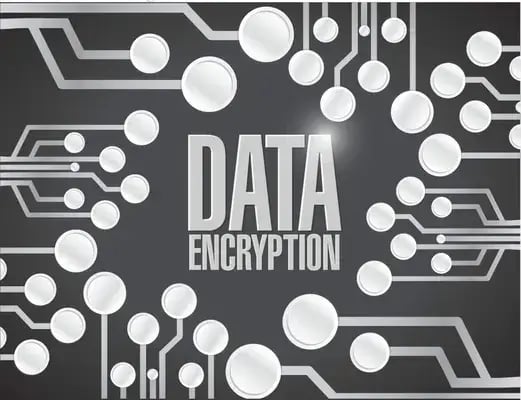The Importance of Data Encryption in Business Security
Date: 15 February 2024

Every business owner has to guard against malicious cyber attacks and ransomware attacks on their company given the increased incidence of cyber crime in the digital landscape. Data encryption has emerged as a powerful tool for protecting business information from compromises or tampering attempts.
This article sheds light on the importance of data encryption as one of the foundations to create a secure business environment. It also covers the benefits, drawbacks, and the practical implementation of data encryption to illustrate why it is so critical in modern life.
Understanding Data Encryption & its Necessity in Business
Data Encryption or recoding is the process of converting data into another form or code such that it is meaningless unless a person has access to a secret key or password. Encryption prevents unauthorised access to sensitive business information including customer data, financial records and intellectual property.
The need for data encryption originates from the growing number of cases where confidentiality losses lead to financial damage as well as serious reputational loss. Encryption acts as a major obstacle for threat actors with criminal intentions, making sure data intercepted or retrieved without authorisation remains inaccessible.
At a time when data is seen as a critical resource, encryption and its ability to act as a digital lock guarantees that no one uses this precious asset without rightful access. This process not only protects the data itself but also ensures that customers as well as business partners feel comfortable and safe working with your organisation – customer trust is strengthened through this demonstration of dedication to the privacy of their information.
Secure Third-Party Data Sharing is an essential component of this demonstration. You can also share information with partners and vendors in an encrypted manner, further building their trust and strengthening the safety of their sensitive information.
Encryption Techniques and Best Practices for Businesses
There are various techniques in data encryption that a business can employ depending on its specific needs.
The first is symmetric encryption, where the same key may be used for both encrypting and decrypting the message. The second is asymmetric encryption which utilises two types of keys - a public and a private key to encrypt and decrypt the data respectively. While symmetric encryption is faster and less complicated to execute, asymmetric encryption is clearly more secure thanks to the use of a private key for decryption. Symmetric encryption, however, remains a preferred choice for those dealing in large data sets due to its ease of implementation.
The first of the best practices in data encryption would be to determine exactly which technique will suit your business best. Other important aspects to focus on include regular updates to the algorithms used, secure management of keys and their protection along with other cryptographic measures aimed at protecting all sensitive data in backup as well as in transit.
It is also necessary for organisations to be conversant with the latest encryption standards and doctrine on data protection policies such as the GDPR and HIPAA.
Finally, a successful approach to encryption should be versatile and changeable. It should be adaptable to change based on an ever-altering cybersecurity landscape with rising risks.
Integrating Encryption into Your Business Operations
Pushing for incorporating encryption into business activities demands a good strategy. This encompasses performing data risk assessment to determine what data needs encryption, selecting suitable tools and services for encryption as well as education of employees on encryption stipulations besides other issues revolving around security of the data.
In particular, businesses could look into working with specialised cybersecurity consultancy firms who can give you unbiased advice on how to upgrade your systems and which type of data deserves encryption. You could also consider rolling out your custom e-learning solution from Oxagile, a high-quality e-learning creating firm, for supporting security features and data encoding. This can also guarantee that your team members have the knowledge and capability to handle the new security features.
In scenarios where businesses face unethical challenges, including defamation potentially fueled by compromised data or misleading information dissemination, it is critical to act decisively. Knowing how to write a defamation cease and desist letter provides a legal avenue for businesses to seek remedy and ensure their reputation remains intact, complementing cybersecurity measures.
Challenges and Considerations in Implementing Data Encryption
The process of encrypting data bits reverses the process that was used for encryption. However, this comes with its own array of difficulties associated with implementation.
These involve the intricacy of controlling encryption keys, the need for hardware to handle encryption operations, and also security checks on anti-availability and identification without undermining end user usability. Data protection mandates from the government should be backed with a list of protocols that businesses need to follow in order to meet safety standards without affecting operational processes.
In addition, placing the encryption solutions into the existing IT structure is a major process and requires proper planning and people with the right skillset. This problem is further compounded in situations with existing systems or when regulatory compliance enforces certain encryption standards. The essence of a reliable encryption strategy lies in its all-embracing nature and applicability.
Future Trends in Data Encryption and Business Security
The words emerging and evolving are verbs attached to both data encryption in business security and the threat that future cyberattacks pose. It is therefore essential to adopt advanced encryption methods and continuously stay abreast with evolutions in encryption technologies.
At the same time, with businesses getting more reliant on cloud computing and adopting IoT devices, encryption has come to encompass a much bigger scope requiring elaborate strategies.
Thus, matching pace with all the developments in these trends is necessary for businesses to maintain data asset protection. The advent of Artificial Intelligence and Machine Learning also opens new doors for improving encryption techniques by automating parts of key management and threat detection.
Conclusion
Summing up, information security through data encryption is imperative not only because of the technical needs of modern businesses but also for protecting business critical information. It offers the final line of defence for security in data that is sensitive, and which allows businesses to protect their reputation as well as ensure compliance with legal regulations.
As evidenced above, applying encryption involves consideration and not an unorganised application; it is a case of needs-to-be-met in terms of security against attacks while balancing functionality. Additionally, efforts ought to be made to ensure that future trends are followed up on as needed.
In the move towards digital transformation, every industry is now realizing the need for encryption as a pivotal pillar of their cybersecurity. Companies which know how to apply proper encryption strategies and comply with modern changes in the digital world can succeed and are increasingly being found better capable of weathering a cyber storm.







-1.webp)
